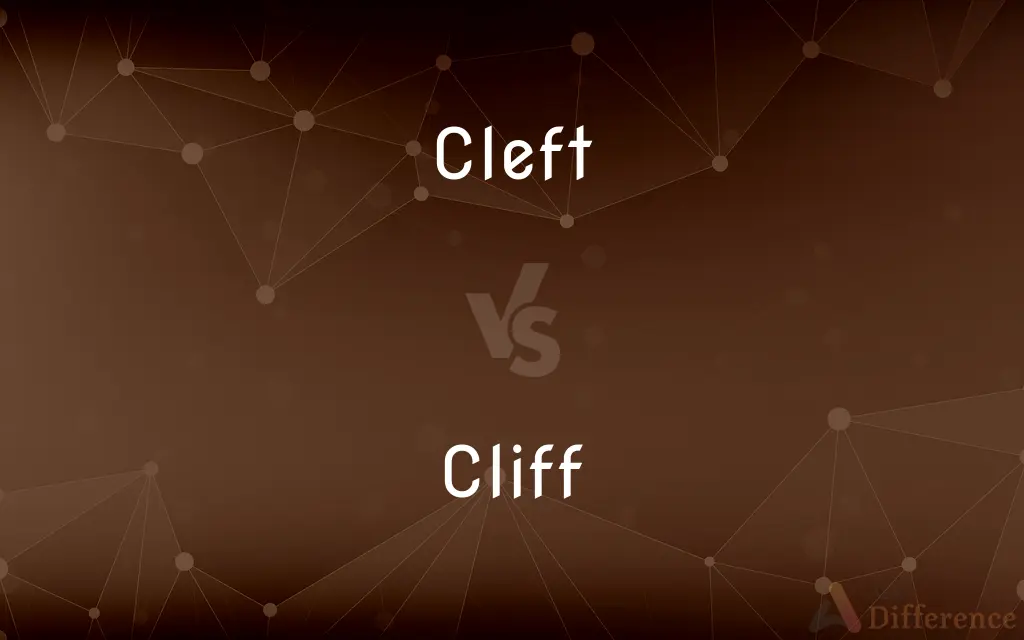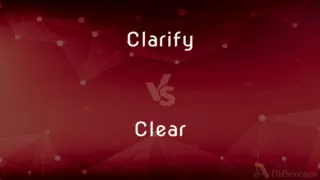Cleft vs. Cliff — What's the Difference?
By Urooj Arif & Fiza Rafique — Updated on April 24, 2024
A cleft is a narrow opening or split in rock, often formed by erosion, while a cliff is a steep face of rock and earth, typically significant in height and formed by erosive processes.

Difference Between Cleft and Cliff
Table of Contents
ADVERTISEMENT
Key Differences
A cleft, also known as a fissure, is usually a smaller feature compared to a cliff, appearing as a crack or split that can vary in depth and width, whereas a cliff presents a large, abrupt discontinuity in the landscape, often forming a dramatic vertical or near-vertical drop.
Clefts are often formed by the mechanical action of water freezing and thawing, which gradually forces rocks apart, while cliffs are primarily shaped by broader erosive forces such as water, wind, and ice, which erode the base or side of a rocky outcrop.
Clefts can be found in a variety of environments, often as minor features in larger rock formations, whereas cliffs are typically associated with more dynamic environments like coastlines, mountain ranges, or riverbanks where constant erosion is evident.
Clefts can create unique microhabitats that support specific plants and animals adapted to shaded and protected conditions, on the other hand, cliffs might host specialized species that can nest on sheer faces or utilize the open, exposed terrain.
In terms of human use, clefts may serve as pathways or natural conduits for water in rural or wilderness areas, whereas cliffs offer opportunities for recreational activities such as climbing, hiking, or as scenic viewpoints.
ADVERTISEMENT
Comparison Chart
Definition
A narrow opening or split in a rock
A steep, high rock face or escarpment
Formation
Often formed by freeze-thaw processes
Formed by erosion from water, wind
Size
Generally smaller and narrower
Larger and more prominent in landscape
Environment
Can occur in varied environments
Often found in dynamic environments
Ecological role
Supports specific microhabitats
Hosts specialized fauna and flora
Compare with Definitions
Cleft
May be associated with small-scale water flow.
A tiny stream trickled through the cleft every spring.
Cliff
A high, steep face of rock, earth, or ice.
The cliff overlooked the ocean, offering breathtaking views.
Cleft
Often found as a feature in cliffs or mountains.
The climbers used the cleft as a natural path to ascend the mountain.
Cliff
Offers unique ecosystems and spectacular views.
The cliff was covered in a rare type of grass that was adapted to harsh, windy conditions.
Cleft
Provides habitat for certain wildlife and plants.
Ferns and mosses thrived in the moist, shaded environment of the cleft.
Cliff
Commonly found along coastlines, in mountains, or beside rivers.
Eagles often nest on the inaccessible ledges of the cliff.
Cleft
A narrow, vertical space that has split open in a rock.
The cleft in the rock provided a perfect hiding spot for the small animals.
Cliff
Subject to erosion from environmental elements.
Waves continuously battered the base of the cliff, causing pieces to fall off.
Cleft
Can be formed by natural erosion or fracturing.
Over time, water seeped into the rock and gradually widened the cleft.
Cliff
A popular location for extreme sports like rock climbing.
The sheer cliff was a favorite challenge for experienced climbers.
Cleft
Past participle of cleave
Cliff
In geography and geology, a cliff is an area of rock which has a general angle defined by the vertical, or nearly vertical. Cliffs are formed by the processes of weathering and erosion, with the effect of gravity.
Cleft
Split, divided, or partially divided into two
A cleft chin
Cliff
A steep rock face, especially at the edge of the sea
A coast path along the top of rugged cliffs
Cleft
A fissure or split, especially in rock or the ground
The third peak is divided from the eastern one by a deep cleft
Cliff
A high, steep, or overhanging face of rock.
Cleft
A past tense and a past participle of cleave1.
Cliff
A vertical (or nearly vertical) rock face.
Cleft
Divided; split.
Cliff
(figurative) A point where something abruptly fails or decreases in value etc.
Cleft
(Botany) Having indentations that extend about halfway to the center, as in certain leaves.
Cliff
A high, steep rock; a precipice.
Cleft
A crack, crevice, or split.
Cliff
See Clef.
Cleft
A split or indentation between two parts, as of the chin.
Cliff
A steep high face of rock;
He stood on a high cliff overlooking the town
A steep drop
Cleft
An opening, fissure, or V-shaped indentation made by or as if by splitting.
Cleft
A piece made by splitting.
A cleft of wood
Cleft
A disease of horses; a crack on the band of the pastern.
Cleft
(linguistics) To syntactically separate a prominent constituent from the rest of the clause that concerns it, such as threat in "The threat which I saw but which he didn't see, was his downfall."
Cleft
Split, divided, or partially divided into two.
Cleft
Divided; split; partly divided or split.
Cleft
Incised nearly to the midrib; as, a cleft leaf.
Cleft
A space or opening made by splitting; a crack; a crevice; as, the cleft of a rock.
Cleft
A piece made by splitting; as, a cleft of wood.
Cleft
A disease in horses; a crack on the band of the pastern.
Cleft
A split or indentation in something (as the palate or chin)
Cleft
A long narrow opening
Cleft
Used of hooves
Cleft
Having one or more incisions reaching nearly to the midrib
Common Curiosities
Why are clefts important in nature?
Clefts can provide microhabitats for various plants and animals, contributing to biodiversity.
How is a cliff formed?
Cliffs are formed through processes such as erosion by water and wind, along with weathering effects.
Can a cleft become a cliff?
Generally, a cleft does not become a cliff as it is typically a smaller formation within larger rock features.
Do clefts have any geological significance?
Yes, clefts can indicate geological activity such as past movements or shifts in the earth's crust.
Can cliffs be found in urban areas?
Yes, cliffs can sometimes be found in urban areas, particularly in cities built near coastal or mountainous regions.
Are clefts dangerous?
While not typically as dangerous as cliffs, clefts can be hazardous if they are deep or unstable.
What is a cleft?
A cleft is a narrow opening or crack, especially in a rock or wall.
What are the common locations for cliffs?
Cliffs are commonly found along ocean coastlines, riverbanks, and mountain ranges.
What activities can be done at a cliff?
Activities such as rock climbing, hiking, and scenic photography are popular at cliffs.
What wildlife is typically found around clefts?
Wildlife in clefts often includes small mammals, insects, and specialized plant species.
How do cliffs affect the environment?
Cliffs can influence local climates and serve as barriers or buffers to environmental elements, supporting specific ecosystems.
Are there cultural significances associated with cliffs?
Many cliffs hold cultural significance, serving as historical or spiritual landmarks.
What is the difference between a cleft and a crevasse?
A cleft is a split in rock, while a crevasse is a deep crack, especially in an ice sheet or glacier.
How do humans utilize cliffs?
Humans utilize cliffs for recreational activities and as unique habitats for tourism and conservation.
What is the ecological impact of a cleft?
Clefts can significantly impact local ecology by providing shelter and habitat continuity within their environments.
Share Your Discovery

Previous Comparison
Clarify vs. Clear
Next Comparison
Fragrance vs. SmellAuthor Spotlight
Written by
Urooj ArifUrooj is a skilled content writer at Ask Difference, known for her exceptional ability to simplify complex topics into engaging and informative content. With a passion for research and a flair for clear, concise writing, she consistently delivers articles that resonate with our diverse audience.
Co-written by
Fiza RafiqueFiza Rafique is a skilled content writer at AskDifference.com, where she meticulously refines and enhances written pieces. Drawing from her vast editorial expertise, Fiza ensures clarity, accuracy, and precision in every article. Passionate about language, she continually seeks to elevate the quality of content for readers worldwide.














































